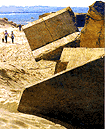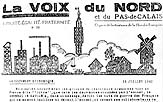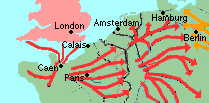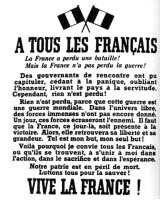Places
to visit
| Background
information |
Find
a book about it Second
World War

1939-45

 French coal-miners working under German military supervision. They actually came out on strike, and many were shot.  Half a century later: ruins of the German's Atlantic Wall defences along the beaches of the north. |
Invasion in
1940 Refugees German administration
1940-45 As the German's launchpad for attacking Britain, north France was littered with military bases, airfields and later rocket launchpads. [see 'V1 and V2 rockets']. Back to top |
|
|
Meanwhile over a third of French production was forcibly given to Germany, paid for by taxes on the French as "occupation costs". Over a third of France's manpower was employed in the German war effort. French
resistance |
|
|
|
In the North particularly, resistance groups were soon actively sabotaging the German war effort and feeding information to the Allies. Once Russia had joined the war, the communists in the coal mining areas were very active. Many were shot when they led a miners strike during the war. Resistance fighters published a secret newsheet called the "Voix du Nord", which after the war became the region's leading newspaper, with offices in the Grand Place in Lille. |
||
  As the fortunes of war turned against the Nazis, they massed thousands of slave labourers to build massive defences - while behind the lines, the Resistance fighters launched a clandestine newspaper, organised sabotage, and fed information to the Allies. |
||
 Progress of Allied liberation of northern France and the low countries after D-Day 1944. |
D-Day and
Liberation Once the Caen bridgehead had been secured after the Normandy landings, Allied forces swept across France more quickly than had been expected. Pockets of German resistance along the coast were by-passed to be dealt with later, as the main advance thrust into Germany. Dunkerque was last to be liberated, only days before the end of the European war in 1945. |
|
|
The cost of the
war Transport was left badly disrupted. As in the rest of war-torn Europe, there was a serious shortage of basic necessities such as fuel and food. After the initial hardships, the effort of reconstruction was to launch France into 30 years of growth and prosperity. Production returned to pre-war levels by the late 'forties. |
||
 |
|
|
A group of museums and
historic sites have joined together to offer you a special
rate if you join their Association, and show your card on
entry. These are: |
|
|
|
|||
|
Other
Places to visit: |
||||
|
Related background
information |
|
|
|
|
|

